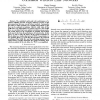Free Online Productivity Tools
i2Speak
i2Symbol
i2OCR
iTex2Img
iWeb2Print
iWeb2Shot
i2Type
iPdf2Split
iPdf2Merge
i2Bopomofo
i2Arabic
i2Style
i2Image
i2PDF
iLatex2Rtf
Sci2ools
ICC
2008
IEEE
2008
IEEE
On the End-to-End Delay Performance of Spatially Correlated Wireless Line Networks
— The analytical end-to-end (e2e) performance of a wireless multihop network is largely unknown, because of the interconnections between several factors involved. Customarily, the nodes are often assumed to be spatially uncorrelated so that they can be analyzed in isolation, which is valid when all the traffic flows are independent. In practice, however, most traffic flows are correlated and cause spatial correlation among nodes. The results based on the assumption of spatially uncorrelated nodes may be far from the performance of real networks. In this paper, we aim to study the impact of the spatial correlation on the e2e delay in a wireless line network (WLN). In particular, we use queueing theory to reveal that the burstiness, the temporal correlation of the traffic flow and the underlying medium access control (MAC), together determine the spatial correlation, from which an analysis of the e2e delay of a WLN is accomplished.
| Added | 30 May 2010 |
| Updated | 30 May 2010 |
| Type | Conference |
| Year | 2008 |
| Where | ICC |
| Authors | Min Xie, Martin Haenggi, Kai-Kit Wong |
Comments (0)

